Widening Access To Music
Disabled and otherwise disadvantaged users, supported by imaginative teachers, therapists and community musicians have found many ways of using the remarkable musical "tool-kit" that goes by the name of "MIDIgrid".
Here are just a few scenarios, with links to the support documentation that will help you try out these ideas for yourself:
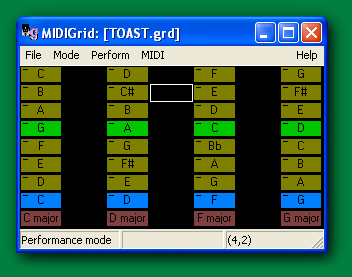
James,
the new music teacher, has found that the school can boast few of the instrumental resources and skills necessary to to explore the simple improvisation ideas he was hoping to introduce to his eager young pupils.
He makes it possible for more children to 'have a go' by creating instruments in MIDIgrid like those in the "Toast" grid. (See Example folder in the installation directory).
Having created several 'instruments' that play a diatonic scale, he finds it easy to quickly adapt them to play the pentatonic, or five-note, gapped scale of Unit 12, UK curriculum. He simply deletes the 4th and 7th note of the scale and saves the adapted grid with a new name
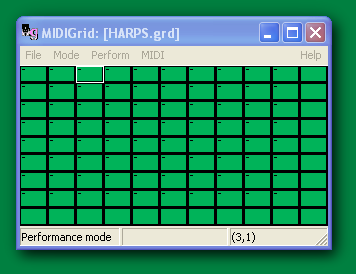
David,
an amateur musician who is quadriplegic, is looking for grids to play with his joystick.
He uses the joystick in conjunction with a little utility called "StickyRightMouseButton" created for MIDIgrid and GridPlay by Joris, at mybreathmymusic.com.
This utility allows the player to toggle between "Right Button: press to play" mode and "Right Button: hold" mode, in which the contents of cells are played as the cursor enters each cell.
Please
contact the publisher.
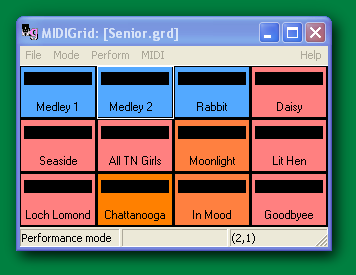
Rachel
runs music sessions in retirement homes. She is a competent pianist but, in these sessions, she needs to engage the active participation of the residents. Playing the piano would prevent her moving around the group and making eye-contact.
It is very simple for Rachel to record songs and backing tracks into a grid. (See MIDIgrid Manual Reference Section 5)
Rachel creates sets of pieces that she is likely to use in quick succession and these are instantly accessible from a single grid. If she wishes, she can schedule playback of a cell and trigger it with an external switch (See MIDIgrid Manual Reference Section 8).
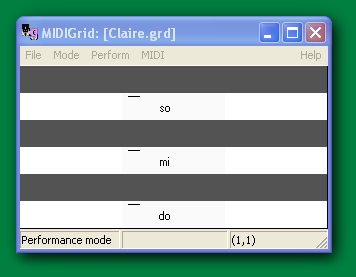
Claire
is keen to follow up with her class the simple "Kodaly" rhythmic and aural activities that the music coordinator has introduced into the school. "I'd like to do it", she says, "but I'm sometimes out of tune, myself."
This gives the coordinator an idea and she sets up a grid in which the notes the children are working on are entered into cells and labelled with the sol-fa syllables (See Examples\DMSFRHRN.GRD in the installation directory). Claire can use this as a confidence-building reference.
Teacher or pupils can also invent rhythms on the notes for others to echo or respond to with pitches or rhythms of their own.
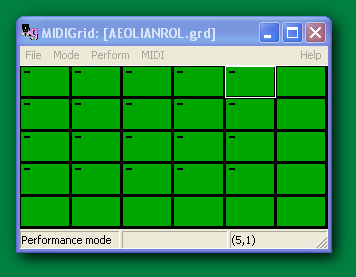
Terry
has profound physical and learning disabilities. His 'instrument' is a trackball with which he accesses the grids created for him by the music facilitator.
Terry rolls the trackball triggering flute sounds as the facilitator improvises on an acoustic flute. A switch locks the Right Button in the 'on' position but the utility 'StickyRightMouseButton' could be used for this purpose (See "David", above).
To read more about Terry and his friends, see http://www.livingmysong.org.uk/pmld.htm.

Julie's
class of young people with physical disabilities includes a couple of switch-users. These pupils are unable to play acoustic instruments or to control a mouse/trackball.
One uses a press-and-release type of switch and is also able to press and release the keys on a music keyboard. Julie makes use of the "Set MIDI Trigger" function in MIDIgrid to assign accompanying chords for the song the class is to perform to keys on the school's MIDI keyboard.
As any key can be set to trigger any cell, Julie can assign the chords of C, F and G (See "12561.GRD" in the "Examples" folder) to adjacent notes, ideal for this pupil's limited range of left-right movement.
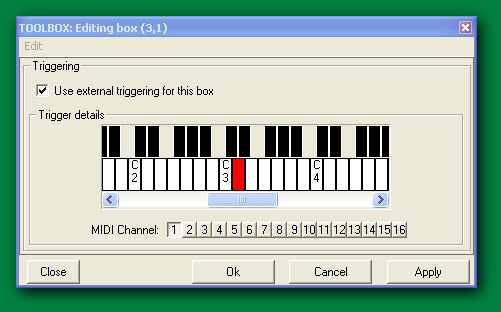
For a pupil with a bigger range of movement but poor accuracy, Julie could duplicate cells, giving them additional triggers, and space them out on the keyboard.
Julie finds that the other pupil, who uses an eye-blink switch, can also be set up to trigger the contents of cells but, in this instance, a MIDI control box is required to connect the switches to the computer. (See
Help & Support for information on external MIDI devices, switches and alternatives to mouse control.
See also:
GridPlay for
Carers/Teachers Home | About MIDIgrid | Demos |
Products | Help & Support | Contact

|